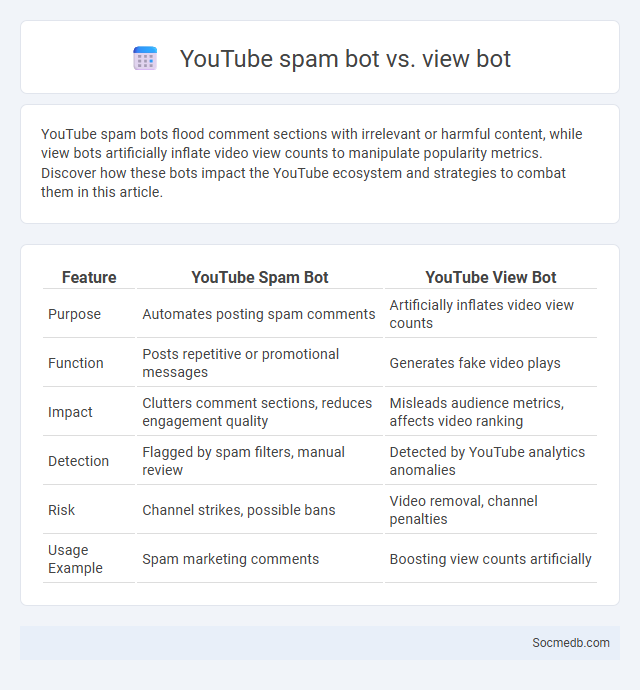
Photo illustration: YouTube spam bot vs view bot
YouTube spam bots flood comment sections with irrelevant or harmful content, while view bots artificially inflate video view counts to manipulate popularity metrics. Discover how these bots impact the YouTube ecosystem and strategies to combat them in this article.
Table of Comparison
| Feature | YouTube Spam Bot | YouTube View Bot |
|---|---|---|
| Purpose | Automates posting spam comments | Artificially inflates video view counts |
| Function | Posts repetitive or promotional messages | Generates fake video plays |
| Impact | Clutters comment sections, reduces engagement quality | Misleads audience metrics, affects video ranking |
| Detection | Flagged by spam filters, manual review | Detected by YouTube analytics anomalies |
| Risk | Channel strikes, possible bans | Video removal, channel penalties |
| Usage Example | Spam marketing comments | Boosting view counts artificially |
Introduction to YouTube Automation: Spam Bots vs. View Bots
YouTube automation involves using software to manage channels, with spam bots designed to flood comment sections with irrelevant messages, while view bots artificially inflate video views to boost popularity metrics. Understanding the distinction between spam bots and view bots is crucial for maintaining channel integrity and adhering to YouTube's policies. Proper automation balances efficiency without compromising authenticity or violating platform guidelines.
Understanding YouTube Spam Bots
YouTube spam bots generate fake comments, likes, and views to manipulate engagement metrics and disrupt genuine user interactions. These bots often use automated scripts to flood videos with irrelevant or promotional content, undermining the platform's content quality and algorithm integrity. Detecting and mitigating spam bots is crucial for maintaining authentic community engagement and safeguarding advertiser investments on YouTube.
What Are YouTube View Bots?
YouTube view bots are automated programs designed to artificially inflate the number of views on videos by generating fake or simulated traffic. These bots mimic human behavior, increasing view counts to make content appear more popular, impacting YouTube's algorithm and potentially misleading advertisers and viewers. Using view bots violates YouTube's terms of service and can lead to penalties such as video removal or channel suspension.
Core Differences: Spam Bots vs. View Bots
Spam bots on social media generate unsolicited and repetitive content, often flooding platforms with fake messages or comments to manipulate engagement metrics or spread malware. View bots, by contrast, artificially inflate video or live stream view counts to boost perceived popularity without genuine user interaction. Understanding the core difference between spam bots and view bots is essential for identifying and mitigating fraudulent activities that skew social media analytics and user experience.
How Spam Bots Operate on YouTube
Spam bots on YouTube automate the posting of irrelevant or misleading comments in bulk to manipulate video engagement metrics and spread malicious links. These bots use algorithms that mimic human behavior to evade detection, often targeting popular videos to maximize reach. YouTube employs machine learning and pattern recognition to identify and remove spam bot activity, enhancing platform security.
Techniques Used by View Bots
View bots manipulate social media algorithms by generating fake engagements such as likes, comments, and shares to artificially inflate content popularity. These bots mimic organic user behavior through randomized interaction patterns and timing to evade detection by platform security systems. You can protect your account by using advanced analytics tools that identify and block suspicious activity linked to view bot networks.
Detection and Penalties: YouTube’s Fight Against Bots
YouTube employs advanced machine learning algorithms and behavioral analysis to detect bot activity, including fake views, comments, and subscriber counts. The platform enforces strict penalties such as removing invalid engagement, demonetizing channels, and temporary or permanent suspension to maintain content authenticity. Continuous updates to detection systems ensure that YouTube mitigates artificial manipulation and protects genuine creators' interests.
Impact of Bots on Channel Growth and Reputation
Bots can significantly influence your social media channel growth by artificially inflating follower counts and engagement metrics, which may initially boost visibility but often leads to reduced trust from real users and platform algorithms. These automated accounts can damage your channel's reputation by spreading spam, misinformation, or irrelevant content, triggering penalties or shadow bans from social media platforms. Ensuring authentic interactions and monitoring follower quality are crucial strategies to maintain genuine growth and a positive brand image.
Legal and Ethical Considerations of Bot Usage
Legal and ethical considerations of bot usage on social media involve compliance with data privacy laws such as GDPR and CCPA to protect user information and prevent unauthorized data harvesting. Ethical concerns include transparency in bot identity to avoid deceptive practices and manipulation of public opinion, which can undermine trust in online platforms. Platforms like Twitter and Facebook enforce strict policies against malicious bot activity to safeguard user interactions and maintain fair digital ecosystems.
Best Practices to Avoid and Report YouTube Bots
Identifying and avoiding YouTube bots involves monitoring for unnatural engagement patterns such as sudden spikes in views, likes, or comments that lack genuine user interaction. Users should report suspicious activity through YouTube's official reporting tools, providing detailed evidence to help the platform investigate and remove fraudulent accounts. Implementing two-factor authentication and regularly reviewing channel analytics can further protect content creators from bot-related manipulation.
 socmedb.com
socmedb.com